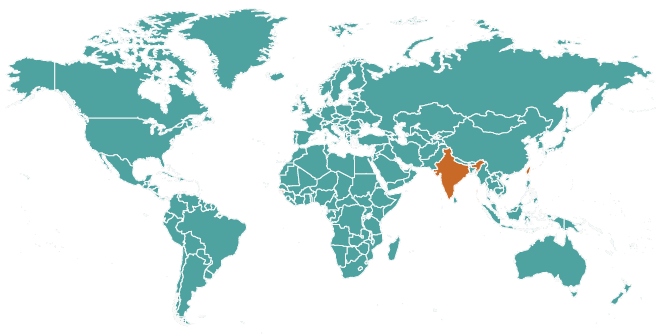
This Friday, March 20, is World Oral Health Day. So, we decided to take a look at some of the oral health issues people face in a few countries and regions around the globe.
In 2016, 3.58 billion people worldwide were affected by oral diseases. In the U.S. and around the world, gum disease and tooth decay consistently rank among the most prevalent conditions impacting people’s health.
Oral Health on the African Continent

Residents of countries across Africa face a few unique oral health challenges. While common oral disease rates are fairly low compared to other regions—only 14 percent of 35- to 44-year-olds and 22 percent of 60- to 69-year-olds experience gum disease—other, sometimes fatal, issues are more prevalent.
Oral and Facial Trauma
Due in large part to political instability and conflict across the continent, oral and facial trauma—broken or chipped teeth and jaw injuries impact as many as one in five children in Africa.
Noma
Noma is a disease most prevalent in sub-Saharan Africa that primarily impacts children suffering from malnutrition. While the gangrenous disease can be stopped and reversed with basic hygiene, antibiotics, and proper nutrition, sadly it is currently fatal in about 90 percent of all cases. When properly treated with antibiotics, noma’s mortality rate decreases to around 8 percent, making the first statistic especially jarring.
HIV
Oral manifestations are some of the earliest visible signs of HIV, making them important indicators of the disease. About 26 million people living in Afria are HIV-positive, accounting for nearly 68 percent of global cases of the disease.
HIV is still uncurable at a large scale, but doctors in London appear to have recently cured the second patient in the world of HIV. The patient received a stem-cell transplant and has been HIV-free for more than 30 months. The first patient to be cured of HIV has been free of the disease since 2011 after receiving a similar treatment.
Healthy China 2030

China is experiencing an ongoing oral health crisis, with tooth decay and gum disease affecting more than half the country’s population. A 2019 study into the oral health status of Chinese residents found that fewer than half of China’s population brush their teeth twice a day.
To respond to its public health crisis, China has launched Healthy China 2030, an initiative to incorporate public health into all of the Chinese government’s policies. Healthy China 2030 includes specific campaigns focused on oral health education, and it aims to shift the focus of health care toward preventive measures. These measures include education, as well as an increased focus on social determinants of health.
Health Care in Brazil

In 1988, Brazil’s government began to implement a government-run healthcare system, making it the only country at the time with more than 200 million residents to implement a plan for universal health care. Funding shortages and other barriers hinder Brazil’s system, and an article in the British Medical Journal of Global Health describes how economic and political instability could reverse the progress made since the 1980s.
Despite the instability of its health care system, Brazil has successfully provided a significantly larger portion of its residents with health care, dramatically improving the overall health of its population.
Brazil’s universal health care system focuses on primary and preventive health care, including oral health. Since 1988, Brazil’s “DMFT” index, or the mean number of decayed, missing, or filled teeth, among its population has decreased considerably. For example, the DMFT index for 12-year-olds has changed from 6.7 to 1.3 since the 1980s.
Unique Challenges In India and Tiawan

Have you heard of the Betel Nut? Chewing a betel nut causes a sense of euphoria and heightened alertness on par with consuming six cups of coffee, and it is incredibly popular in countries like India and Tiawan. A simple tree nut may not seem threatening, but this particular one is a potent carcinogen that has created an oral health crisis among its users.
Betel nut chewing can lead to a variety of oral diseases, including oral cancer and pre-cancerous lesions. In fact, 80 to 90 percent of Tiawanese residents diagnosed with oral cancer or pre-cancer chew betel nuts.
The time it takes for negative effects to develop makes the betel nut especially dangerous. This article from the BBC details the journey of one nut chewer, Qui Zhen-huang, who started chewing betel nut because, “everyone at work did it.”
He chewed for ten years and then quit. Twenty years after quitting, he developed oral cancer in the form of a golf ball-sized tumor and a hole in his left cheek.
The first references to betel nut chewing appeared in ancient Greek, Sanskrit, and Chinese literature. The tradition’s span of two or more millennia makes it a hard one to break, so governments are having a hard time convincing their citizens to quit.
In Tiawan, the government actually pays people to voluntarily cut down betel nut palms. In India, on the other hand, betel nut production has tripled since 1961. Some states and territories in India have implemented bans on specific betel nut products, especially ones that combine the nut with tobacco. However, the bans haven’t seemed to have much of an impact on its production and consumption.
Make A Difference Locally
To learn more and get involved with oral health improvement efforts here in North Carolina, visit our Oral Health Day 2020 page to see what we are planning for our signature advocacy event on June 3rd. If you’d like to receive updates about stories like this directly to your inbox, be sure to sign up for NCOHC news.
NCOHC is a program of the Foundation for Health Leadership & Innovation. For more information and to stay up to date, subscribe to the NCOHC newsletter. If you’re interested in becoming an NCOHC member, you can also fill out our membership form. It’s free!

